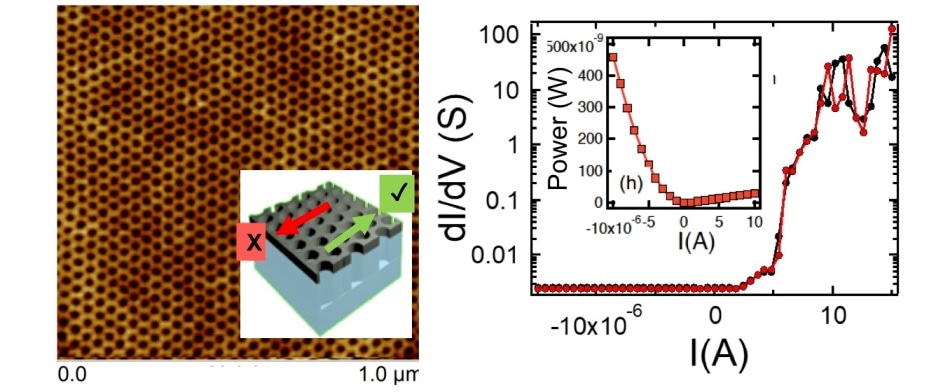May 17 2018
Top complaints from users concerning laptop, smartphone, and other battery-operated electronics are very short battery life and—in certain cases—the devices generate heat. Now, a team of physicists led by Deepak K. Singh, associate professor of physics and astronomy at the University of Missouri, have created a device material that can resolve both issues. The team has applied for a patent for a magnetic material that uses a distinctive structure—a “honeycomb” lattice that displays unique electronic properties.
 The left shows the atomic force micrograph, exhibiting honeycomb structure pattern behind a magnetic device. The inset shows the schematic of current flow direction. On the right: electrical data reveals the diode-type behavior of current flowing in one direction. The inset shows that the dissipative power is of the order of nano-watt in the current flowing direction, which is at least three orders of magnitude smaller than the semiconductor diode. (Image credit: Deepak Singh)
The left shows the atomic force micrograph, exhibiting honeycomb structure pattern behind a magnetic device. The inset shows the schematic of current flow direction. On the right: electrical data reveals the diode-type behavior of current flowing in one direction. The inset shows that the dissipative power is of the order of nano-watt in the current flowing direction, which is at least three orders of magnitude smaller than the semiconductor diode. (Image credit: Deepak Singh)
Semiconductor diodes and amplifiers, which often are made of silicon or germanium, are key elements in modern electronic devices. A diode normally conducts current and voltage through the device along only one biasing direction, but when the voltage is reversed, the current stops. This switching process costs significant energy due to dissipation, or the depletion of the power source, thus affecting battery life. By substituting the semiconductor with a magnetic system, we believed we could create an energetically effective device that consumes much less power with enhanced functionalities.
Deepak K. Singh, Chief Investigator of the Magnetism and Superconductivity Research Laboratory at MU
Singh’s team developed a two-dimensional, nanostructured material by placing a magnetic alloy, or permalloy, on the honeycomb structured template of a silicon surface. The new material is capable of conducting unidirectional current, or currents that only travel one way. The material also has considerably less dissipative power than a semiconducting diode, which is typically included in electronic devices.
The magnetic diode opens the door to new magnetic transistors and amplifiers that waste very little power, thus boosting the efficiency of the power source. This could mean that designers could expand the life of batteries by over a hundred-fold. Less dissipative power in computer processors could also decrease the heat produced in laptop or desktop CPUs.
Although more works need to be done to develop the end product, the device could mean that a normal 5-hour charge could increase to more than a 500-hour charge. The device could also act as an ‘on/off switch’ for other periphery components such as closed-circuit cameras or radio frequency attenuators, which reduces power flowing through a device. We have applied for a U.S. patent and have begun the process of incorporating a spin-off company to help us take the device to market.
Deepak K. Singh, Chief Investigator of the Magnetism and Superconductivity Research Laboratory at MU
The planned startup company related with this research showcases the university’s influence on the state’s economic development efforts, including commercialization of research done at Mizzou, workforce development and job growth, attracting businesses and corporations to the state, and quality of life improvements for residents. Companies marketing MU technologies have gained hundreds of millions of dollars in investments and grants to promote their commercialization efforts. In 2017, the Office of Technology Management and Industry Relations reported that 31 U.S. patents were issued to MU members.
The studies, “Magnetic Diode Behavior at Room Temperature in 2D Honeycombs” and “Spin Solid versus Magnetic Charge Ordered State in Artificial Honeycomb Lattice of Connected Elements,” were reported in Advanced Electronic Materials and Advanced Science, respectively. This research received funding from the U.S. Department of Energy, Office of Basic Energy Sciences (DE-SC0014461).